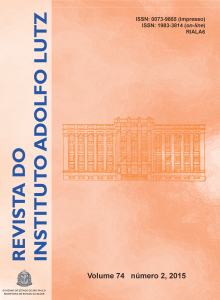Abstract
This study aimed at evaluating the biofilm formation of Shiga toxin-producing Escherichia coli O153:H25, O113:H21 and O111:H8 (STEC non-O157), isolated from Brazilian cattle, on the stainless steel surface, and also the efficacy of different s concentrations of sodium hypochlorite for inactivating these biofilms. The ability to form biofilm was demonstrated in all of Shiga toxin-producing E. coli strains. In assessing the effectiveness of sodium hypochlorite sanitizer, a reduction to <1 log CFU/cm2 was observed in all of the evaluated strains and times. These data strengthen the relevance of the correct cleaning procedure, considering that biofilms formations might be an important source of food contamination.
References
1. Caprioli A, Tozzi AE, Rizzoni G, Karch H. Non-O157 Shiga toxin-producing Escherichia coli infections in Europe. Emerg Infect Dis.1997;3:578-9. [DOI: 10.3201/eid0304.970425].
2. Ethelberg S, Smith B, Torpdahl M, Lisby M, Boel J, Jensen T et al. Outbreak of non-O157 shiga toxin-producing Escherichia coli infection from consumption of beef sausage. Clinic Infect Dis. 2009;48:78-81. [DOI: 10.1086/597502].
3. Johnson RP, Clarke RC, Wilson JB, Read SC, Rahn K, Renwick SA et al. Growing concerns and recent outbreaks involving non-O157 serotypes of verotoxigenic Escherichia coli. J Food Prot. 1996;59(10):1112-22.
4. Paton AW, Paton JC. Detection and characterization of Shiga toxigenic Escherichia coli by using multiplex PCR assays for stx1, stx2, eae, enterohemorrhagic E .coli hlyA, rfb0111, and rfb0157. J Clin Microbiol. 1998;36:598-602.
5. Beutin L, Geier D, Steinruck H, Zimmermann S, Scheurtz F. Prevalence and some properties of verotoxin (Shiga-like toxin) producing Escherichia coli in seven differente species of health domestical animals. J Clin Microbiol.1993;31:2483-8.
6. Vogeleer P, Tremblay YDN, Mafu AA, Jacques M, Harel J. Life on the outside: role of biofilms in environmental persistence of Shiga-toxin producing Escherichia coli. Front Microbiol.2014;5(317):1-12. [DOI:10.3389/fmicb.2014.00317].
7. Wang R, Bono JL, Kalchayanand N, Shackelford S, Harhay DM. Biofilm formation by Shiga toxin-producing Escherichia coli O157:H7 and non-O157 strain and their tolerance to sanitizers commonly used in the food processing environment. J Food Prot.2012;75(8):1418-28. [DOI:10.4315/0362-028x.jfp-11-427].
8. Zottola EA, Sasahara KC. Microbial biofilms in the food processing industry – Should they be a concern? Int J Food Microbiol.1994;23:125-48. [DOI: 10.1016/0168-1605(94)90047-7].
9. Gândara ALN, Oliveira JS. Adesão de linhagem selvagem de Streptococcus thermophilus em superfície de aço inoxidável e efeitos da higienização na sua remoção. Ciênc Tecnol Aliment.2000;20(1):1-7. [DOI: 10.1590/S0101-20612000000100001].
10. Sharma M, Anand SK. Biofilms evaluation as an essential component of HACCP for food/dairy processing industry – a case. Food Control.2002;13(6-7):469-77. [DOI: 10.1016/S0956-7135(01)00068-8].
11. Shi X, Zhu X. Biofilm formation and food safety in food industries. Trends Food Sci Tech. 2009;20(9):407-13. [DOI: 10.1016/j.tifs.2009.01.054].
12. Farrockh C, Jordan K, Auvray F, Glass K, Oppegaard H, Raynaud S et al. Review of Shiga-toxin-producing Escherichia coli(STEC) and their significance in dairy production. Int J Food Microbiol.2013;162:190-212. [DOI:10.1016/j.ifoodmicro.2012.08.008].
13. Gonzalez AGM. Características fenotípicas e genotipicas de cepas de Escherichia coli produtoras de toxina Shiga (STEC) isoladas de bovinos no Estado do Rio de Janeiro [tese de doutorado]. Rio de Janeiro (RJ): Universidade Federal do Rio de Janeiro, 2003.
14. Zadik PM, Chapman PA, Siddons CA. Use of tellurite for the selection of verocytotoxigenic Escherichia coli O157. J Med Microbiol.1993;39(2):155-8.
15. Esper RML. Enterobacter sakazakii (Cronobacterspp.) e Bacillus cereus: Quorum sensing, formação de biofilme e ação de sanitizante [tese de doutorado]. Campinas (SP): Universidade Estadual de Campinas, 2010.
16. Parizzi SQF, Andrade NJ, Silva CAS, Soares NFFS, Silva EAM. Bacterial adherence to different inert surfaces evaluated by epifluorescence microscopy and plate count method. Braz Arch Biol Technol.2004;47(1):77-83. [DOI: 10.1590/S1516-89132004000100011].
17. Biscola FT, Abe CM, Guth BEC. Determination of adhesin gene sequences in, and biofilm formation by, O157 and non-O157 Shiga toxin-producing Escherichia coli strains isolated from different sources. Appl Environ Microbiol.2011;77(7):2201-08. [DOI:10.1128/AEM.01920-10].
18. Fouladkhah A, Geornaras I, Sofos JN. Biofilm formation of O157 and non-O157 Shiga toxin-producing Escherichia coli and multidrug-resistant and susceptible Salmonella Typhimurium and newport and their inactivation by sanitizers. J Food Sci.2013;78:880-6. [DOI: 10.1111/1750-3841.12123].
19. Rivas L, Dykes GA, Fegan N. A comparative study of biofilm formation by Shiga toxigenic Escherichia coli using epifluorescence microscopy on stainless steel and microtitre plate method. J Microbiol Meth.2007;69:44-51. [DOI: 10.1111/1750-3841.12123].
20. Meyer B. Approaches to prevention, removal and killing of biofilms. Int Biodeter Biodegr. 2003;51(4):249-53. [DOI: 10.1016/20964-8305(03)00047-7].
21. Santos MV. Boas Práticas de produção associadas à higiene de ordenha e qualidade do leite. In: O Brasil e a nova era do mercado do leite – Compreender para competir. 1ª ed. Piracicaba: Agripoint Ltda; 2007.p.135-54.

This work is licensed under a Creative Commons Attribution 4.0 International License.
Copyright (c) 2016 Instituto Adolfo Lutz Journal
